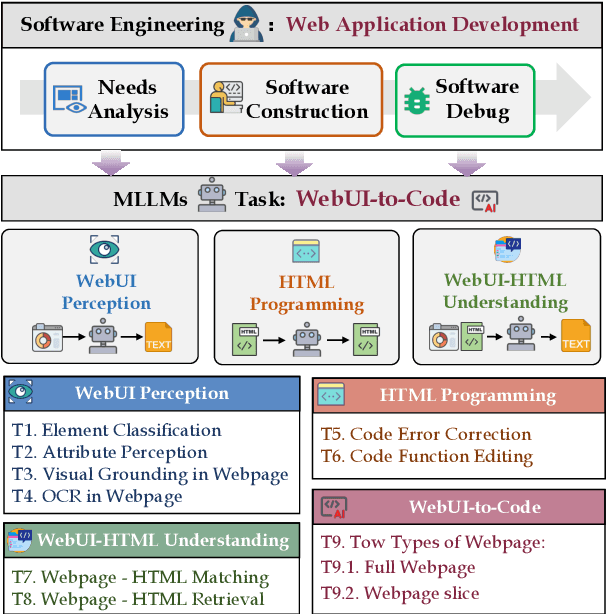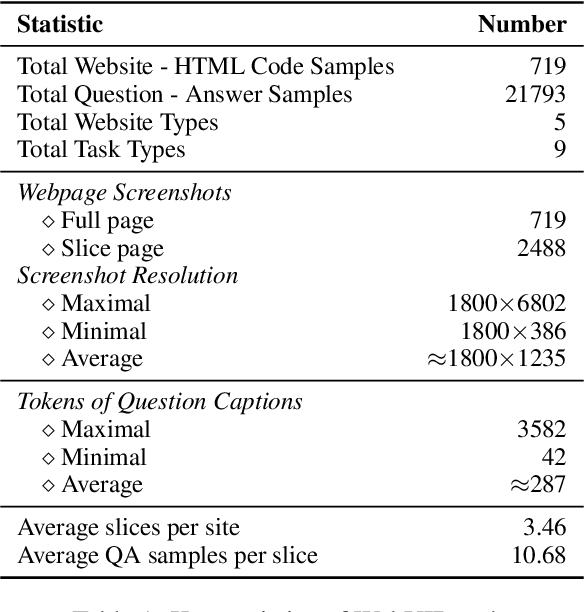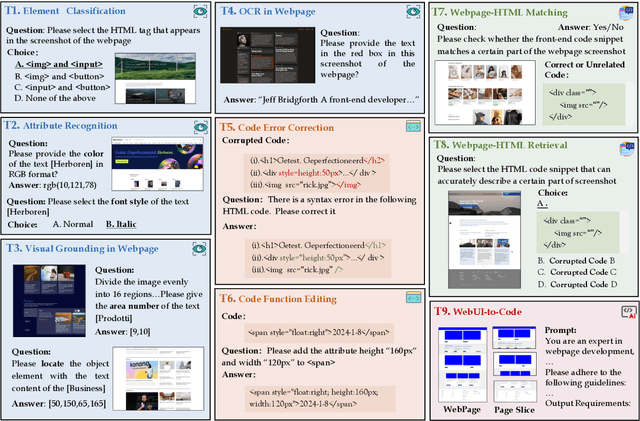Zhiyuan Zhao
OmniLayout: Enabling Coarse-to-Fine Learning with LLMs for Universal Document Layout Generation
Oct 30, 2025Abstract:Document AI has advanced rapidly and is attracting increasing attention. Yet, while most efforts have focused on document layout analysis (DLA), its generative counterpart, document layout generation, remains underexplored. A major obstacle lies in the scarcity of diverse layouts: academic papers with Manhattan-style structures dominate existing studies, while open-world genres such as newspapers and magazines remain severely underrepresented. To address this gap, we curate OmniLayout-1M, the first million-scale dataset of diverse document layouts, covering six common document types and comprising contemporary layouts collected from multiple sources. Moreover, since existing methods struggle in complex domains and often fail to arrange long sequences coherently, we introduce OmniLayout-LLM, a 0.5B model with designed two-stage Coarse-to-Fine learning paradigm: 1) learning universal layout principles from OmniLayout-1M with coarse category definitions, and 2) transferring the knowledge to a specific domain with fine-grained annotations. Extensive experiments demonstrate that our approach achieves strong performance on multiple domains in M$^{6}$Doc dataset, substantially surpassing both existing layout generation experts and several latest general-purpose LLMs. Our code, models, and dataset will be publicly released.
MelCap: A Unified Single-Codebook Neural Codec for High-Fidelity Audio Compression
Oct 02, 2025Abstract:Neural audio codecs have recently emerged as powerful tools for high-quality and low-bitrate audio compression, leveraging deep generative models to learn latent representations of audio signals. However, existing approaches either rely on a single quantizer that only processes speech domain, or on multiple quantizers that are not well suited for downstream tasks. To address this issue, we propose MelCap, a unified "one-codebook-for-all" neural codec that effectively handles speech, music, and general sound. By decomposing audio reconstruction into two stages, our method preserves more acoustic details than previous single-codebook approaches, while achieving performance comparable to mainstream multi-codebook methods. In the first stage, audio is transformed into mel-spectrograms, which are compressed and quantized into compact single tokens using a 2D tokenizer. A perceptual loss is further applied to mitigate the over-smoothing artifacts observed in spectrogram reconstruction. In the second stage, a Vocoder recovers waveforms from the mel discrete tokens in a single forward pass, enabling real-time decoding. Both objective and subjective evaluations demonstrate that MelCap achieves quality on comparable to state-of-the-art multi-codebook codecs, while retaining the computational simplicity of a single-codebook design, thereby providing an effective representation for downstream tasks.
MinerU2.5: A Decoupled Vision-Language Model for Efficient High-Resolution Document Parsing
Sep 26, 2025Abstract:We introduce MinerU2.5, a 1.2B-parameter document parsing vision-language model that achieves state-of-the-art recognition accuracy while maintaining exceptional computational efficiency. Our approach employs a coarse-to-fine, two-stage parsing strategy that decouples global layout analysis from local content recognition. In the first stage, the model performs efficient layout analysis on downsampled images to identify structural elements, circumventing the computational overhead of processing high-resolution inputs. In the second stage, guided by the global layout, it performs targeted content recognition on native-resolution crops extracted from the original image, preserving fine-grained details in dense text, complex formulas, and tables. To support this strategy, we developed a comprehensive data engine that generates diverse, large-scale training corpora for both pretraining and fine-tuning. Ultimately, MinerU2.5 demonstrates strong document parsing ability, achieving state-of-the-art performance on multiple benchmarks, surpassing both general-purpose and domain-specific models across various recognition tasks, while maintaining significantly lower computational overhead.
PromptEnhancer: A Simple Approach to Enhance Text-to-Image Models via Chain-of-Thought Prompt Rewriting
Sep 04, 2025Abstract:Recent advancements in text-to-image (T2I) diffusion models have demonstrated remarkable capabilities in generating high-fidelity images. However, these models often struggle to faithfully render complex user prompts, particularly in aspects like attribute binding, negation, and compositional relationships. This leads to a significant mismatch between user intent and the generated output. To address this challenge, we introduce PromptEnhancer, a novel and universal prompt rewriting framework that enhances any pretrained T2I model without requiring modifications to its weights. Unlike prior methods that rely on model-specific fine-tuning or implicit reward signals like image-reward scores, our framework decouples the rewriter from the generator. We achieve this by training a Chain-of-Thought (CoT) rewriter through reinforcement learning, guided by a dedicated reward model we term the AlignEvaluator. The AlignEvaluator is trained to provide explicit and fine-grained feedback based on a systematic taxonomy of 24 key points, which are derived from a comprehensive analysis of common T2I failure modes. By optimizing the CoT rewriter to maximize the reward from our AlignEvaluator, our framework learns to generate prompts that are more precisely interpreted by T2I models. Extensive experiments on the HunyuanImage 2.1 model demonstrate that PromptEnhancer significantly improves image-text alignment across a wide range of semantic and compositional challenges. Furthermore, we introduce a new, high-quality human preference benchmark to facilitate future research in this direction.
Secure Tug-of-War (SecTOW): Iterative Defense-Attack Training with Reinforcement Learning for Multimodal Model Security
Jul 29, 2025Abstract:The rapid advancement of multimodal large language models (MLLMs) has led to breakthroughs in various applications, yet their security remains a critical challenge. One pressing issue involves unsafe image-query pairs--jailbreak inputs specifically designed to bypass security constraints and elicit unintended responses from MLLMs. Compared to general multimodal data, such unsafe inputs are relatively sparse, which limits the diversity and richness of training samples available for developing robust defense models. Meanwhile, existing guardrail-type methods rely on external modules to enforce security constraints but fail to address intrinsic vulnerabilities within MLLMs. Traditional supervised fine-tuning (SFT), on the other hand, often over-refuses harmless inputs, compromising general performance. Given these challenges, we propose Secure Tug-of-War (SecTOW), an innovative iterative defense-attack training method to enhance the security of MLLMs. SecTOW consists of two modules: a defender and an auxiliary attacker, both trained iteratively using reinforcement learning (GRPO). During the iterative process, the attacker identifies security vulnerabilities in the defense model and expands jailbreak data. The expanded data are then used to train the defender, enabling it to address identified security vulnerabilities. We also design reward mechanisms used for GRPO to simplify the use of response labels, reducing dependence on complex generative labels and enabling the efficient use of synthetic data. Additionally, a quality monitoring mechanism is used to mitigate the defender's over-refusal of harmless inputs and ensure the diversity of the jailbreak data generated by the attacker. Experimental results on safety-specific and general benchmarks demonstrate that SecTOW significantly improves security while preserving general performance.
LLMs Caught in the Crossfire: Malware Requests and Jailbreak Challenges
Jun 09, 2025Abstract:The widespread adoption of Large Language Models (LLMs) has heightened concerns about their security, particularly their vulnerability to jailbreak attacks that leverage crafted prompts to generate malicious outputs. While prior research has been conducted on general security capabilities of LLMs, their specific susceptibility to jailbreak attacks in code generation remains largely unexplored. To fill this gap, we propose MalwareBench, a benchmark dataset containing 3,520 jailbreaking prompts for malicious code-generation, designed to evaluate LLM robustness against such threats. MalwareBench is based on 320 manually crafted malicious code generation requirements, covering 11 jailbreak methods and 29 code functionality categories. Experiments show that mainstream LLMs exhibit limited ability to reject malicious code-generation requirements, and the combination of multiple jailbreak methods further reduces the model's security capabilities: specifically, the average rejection rate for malicious content is 60.93%, dropping to 39.92% when combined with jailbreak attack algorithms. Our work highlights that the code security capabilities of LLMs still pose significant challenges.
WebUIBench: A Comprehensive Benchmark for Evaluating Multimodal Large Language Models in WebUI-to-Code
Jun 09, 2025



Abstract:With the rapid advancement of Generative AI technology, Multimodal Large Language Models(MLLMs) have the potential to act as AI software engineers capable of executing complex web application development. Considering that the model requires a confluence of multidimensional sub-capabilities to address the challenges of various development phases, constructing a multi-view evaluation framework is crucial for accurately guiding the enhancement of development efficiency. However, existing benchmarks usually fail to provide an assessment of sub-capabilities and focus solely on webpage generation outcomes. In this work, we draw inspiration from the principles of software engineering and further propose WebUIBench, a benchmark systematically designed to evaluate MLLMs in four key areas: WebUI Perception, HTML Programming,WebUI-HTML Understanding, and WebUI-to-Code. WebUIBench comprises 21K high-quality question-answer pairs derived from over 0.7K real-world websites. The extensive evaluation of 29 mainstream MLLMs uncovers the skill characteristics and various weakness that models encountered during the development process.
TimeRecipe: A Time-Series Forecasting Recipe via Benchmarking Module Level Effectiveness
Jun 06, 2025Abstract:Time-series forecasting is an essential task with wide real-world applications across domains. While recent advances in deep learning have enabled time-series forecasting models with accurate predictions, there remains considerable debate over which architectures and design components, such as series decomposition or normalization, are most effective under varying conditions. Existing benchmarks primarily evaluate models at a high level, offering limited insight into why certain designs work better. To mitigate this gap, we propose TimeRecipe, a unified benchmarking framework that systematically evaluates time-series forecasting methods at the module level. TimeRecipe conducts over 10,000 experiments to assess the effectiveness of individual components across a diverse range of datasets, forecasting horizons, and task settings. Our results reveal that exhaustive exploration of the design space can yield models that outperform existing state-of-the-art methods and uncover meaningful intuitions linking specific design choices to forecasting scenarios. Furthermore, we release a practical toolkit within TimeRecipe that recommends suitable model architectures based on these empirical insights. The benchmark is available at: https://github.com/AdityaLab/TimeRecipe.
Accelerating Visual Reinforcement Learning with Separate Primitive Policy for Peg-in-Hole Tasks
Apr 21, 2025Abstract:For peg-in-hole tasks, humans rely on binocular visual perception to locate the peg above the hole surface and then proceed with insertion. This paper draws insights from this behavior to enable agents to learn efficient assembly strategies through visual reinforcement learning. Hence, we propose a Separate Primitive Policy (S2P) to simultaneously learn how to derive location and insertion actions. S2P is compatible with model-free reinforcement learning algorithms. Ten insertion tasks featuring different polygons are developed as benchmarks for evaluations. Simulation experiments show that S2P can boost the sample efficiency and success rate even with force constraints. Real-world experiments are also performed to verify the feasibility of S2P. Ablations are finally given to discuss the generalizability of S2P and some factors that affect its performance.
How Can Time Series Analysis Benefit From Multiple Modalities? A Survey and Outlook
Mar 14, 2025Abstract:Time series analysis (TSA) is a longstanding research topic in the data mining community and has wide real-world significance. Compared to "richer" modalities such as language and vision, which have recently experienced explosive development and are densely connected, the time-series modality remains relatively underexplored and isolated. We notice that many recent TSA works have formed a new research field, i.e., Multiple Modalities for TSA (MM4TSA). In general, these MM4TSA works follow a common motivation: how TSA can benefit from multiple modalities. This survey is the first to offer a comprehensive review and a detailed outlook for this emerging field. Specifically, we systematically discuss three benefits: (1) reusing foundation models of other modalities for efficient TSA, (2) multimodal extension for enhanced TSA, and (3) cross-modality interaction for advanced TSA. We further group the works by the introduced modality type, including text, images, audio, tables, and others, within each perspective. Finally, we identify the gaps with future opportunities, including the reused modalities selections, heterogeneous modality combinations, and unseen tasks generalizations, corresponding to the three benefits. We release an up-to-date GitHub repository that includes key papers and resources.
 Add to Chrome
Add to Chrome Add to Firefox
Add to Firefox Add to Edge
Add to Edge